Intuitive remains the dominant surgical robotics company, but corporations ranging from Medtronic to Vicarious Surgical look to compete.

Robotic-assisted surgery remains one of the hottest spaces in medtech. Intuitive, which pioneered the field in the 1990s and early 2000s, continues to innovate. At the same time, a host of other companies are looking to compete.
Companies making headlines in the robotic surgery space over the past year include:
| Company | Robotic system(s) |
| Intuitive Surgical | Da Vinci Xi, Da Vinci X, Da Vinci SP, Ion |
| Medtronic | Hugo |
| Johnson & Johnson | Monarch, Velys, Ottava |
| Stryker | Mako |
| Siemens Healthineers’ Corindus | CorPath GRX |
| Vicarious Surgical | Beta 2 |
| Titan Medical | Enos |
| Asensus Surgical | Senhance |
| Moon Surgical | Maestro |
| Momentus Surgical | Anovo |
| Virtual Incision | MIRA |
| Stereotaxis | Genesis RMN, Vdrive, Niobe |
| Monteris Medical | NeuroBlate |
| Zimmer Biomet | Rosa |
| Smith+Nephew | Cori |
| EndoQuest | ELS |
Here is the latest news on some of the most notable companies in robotic surgery:
Intuitive Surgical: Work continues on next-gen robots
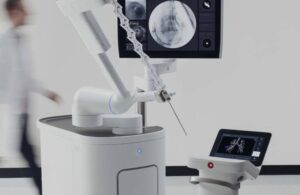
Work continues on the next generations of Intuitive’s robotic systems, CEO Gary Guthart said during the company’s Q2 earnings call last month.
Guthart, however, also acknowledged that deeper technological opportunities and clinical impact also mean deeper validation work. “And we’re not afraid of that work. I’d rather do things that are really clinically meaningful for the customer. … So it’s taking a little longer to get to market than it used to, maybe more than a little, it’s costing us more to get there. But that change in environment also means that really well-designed systems probably have longer useful life in the field. And I think we’re starting to see that early evidence of that as well.” (Guthart will deliver a keynote at DeviceTalks West, Oct. 19–20, 2022 in Santa Clara, California.)
Founded in 1995, Intuitive remains the dominant company in the robot-assisted surgery space with its Da Vinci robots. But it is facing challenges. For example, trade-ins of da Vinci robots are significantly down because there’s a lower volume of older-generation systems out there. There are also supply chain disruptions impacting the timing of system builds. Meanwhile, hospitals are feeling pressure on their spending.
Medtronic: Doing a limited market release with Hugo
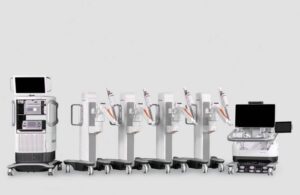
Medtronic is continuing with the limited European market release of its Hugo robotic-assisted surgery system. Hugo represents the medtech giant’s bid to take on Intuitive in the space. During Medtronic’s Q4 earnings call in May, company officials said Hugo was in eight countries. There were installs in France, Italy and Denmark during the most recent quarter. They also reported progress on supply chain challenges related to the system.
The U.S. FDA granted Hugo an investigational device exemption approval last year. Bob White, EVP and president of the Medical Surgical Portfolio, said in May that the company hoped to commence the resulting pivotal trial soon. Medtronic was working closely to train the site personnel and gain Institutional Review Board approval.
There was Hugo’s regulatory approval in Brazil in Saudi Arabia, which followed Canada and Australia. “We’ve begun general surgery cases in Panama, in Chile, in India. And now we’ve done procedures across urology, gynecology and general surgery, including our first bariatric case, which was a nice milestone,” White said.
CEO Geoff Martha added: “We really gained a lot of confidence that we have something in Hugo, and we see a nice ramp in [fiscal year 2023].”
Hugo combines wristed instruments, 3D visualization and Medtronic’s cloud-based surgical video capture and management solution, Touch Surgery Enterprise. The idea is to offer a multi-quadrant platform for a wide range of soft tissue procedures.
As the company’s VP of Marketing for Surgical Robotics Mike Stow related at DeviceTalks Boston in May: “We looked at the current state of robotics going back 10-plus years, and we realized there was an opportunity for us to come in. Customers were saying, ‘Hey, could you make something more flexible that fits better into our rooms and into our hospital setting?’”
In the robotic spine surgery space, Medtronic, in Q4 2022, saw record sales of its StealthStation navigation, O-arm, and Mazor systems.
Johnson & Johnson: Questions about Ottava
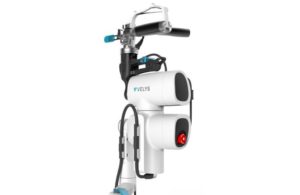
“We recognize that we will have to continue to be committed to developing Ottava and entering into the general surgery market with a highly competitive offering. And we are working through that as soon as possible, and we will provide updates as we progress,” Johnson & Johnson CEO Joaquin Duato said during the company’s Q4 earnings call in January, transcribed by The Motley Fool.
That was the last time that J&J management mentioned Ottava in an earnings call.
A company statement shared with MassDevice yesterday said: “We continue to be committed to and very excited about the Ottava program and look forward to bringing a competitive product to the market with better outcomes for patients.”
Meanwhile, Fortis Advisors has an active lawsuit in Delaware on behalf of the Auris shareholders who were behind the Ottava technology and the previous Monarch robotic system that J&J presently has cleared for certain indications. (Monarch won a new 510(k) in May.)
J&J acquired Auris in 2019 for $3.4 billion. The Fortis lawsuit alleges that the Auris team was subjected post-acquisition to a covert “bakeoff” with Verb Surgical — the joint venture that J&J had with Google’s sister company Verily. The internal competition diverted employees and resources, according to the lawsuit.
J&J describes the lawsuit as “wholly without merit.”
Despite the questions about Ottava, Monarch continues to advance. The recent 510(k) for urology opens it to the kidney stone treatment space. Company officials in April said Monarch-enabled procedures now exceed 14,000 since launch.
In the ortho robotic surgery space, Velys system procedures are over 2,000, company officials added. J&J’s DePuy Synthes orthopedic device business boasts that Velys is a first-of-its-kind, table-mounted ortho surgery robot with an efficient design that integrates into any operating room. (DePuy Synthes officials discussed Velys during a DeviceTalks Weekly podcast in January.)
Stryker: Mako sales remain strong
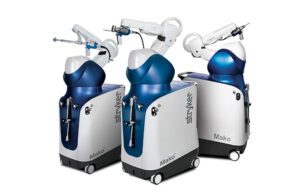
Despite increased competition in the robotic orthopedic surgery space from J&J’s DePuy Synthes, Zimmer Biomet and Smith+Nephew, Stryker is still enjoying increased Mako sales.
Mako sales were up 19% year-over-year in Q2 2022, Investor Relations VP Jason Beach said during Stryker’s most recent earnings call. Beach added: “We are pleased with how the growing installation base continues to fuel market-leading implant growth. The order book remains strong for Mako, and the percentage of implants using the robot continues to increase.”
However, CEO Kevin Lobo noted that there is less revenue per quarter from Mako because more health providers are turning to financing and rental agreements when it comes to the system.
“We are not really worried because we’ve had virtually no returns of our product,” Lobo said during the call, transcribed by Seeking Alpha. “Once we get our products in … we have highly utilized machines.”
Siemens Healthineers’ Corindus: A new headquarters
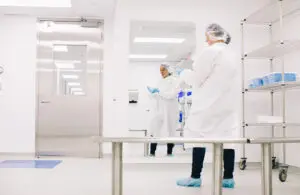
Corindus is the creator of the CorPath GRX system. The company describes the CorPath GRX as the first and only FDA-cleared and CE-marked medical device for robotic-assisted coronary interventions. The system has also enabled Corindus to be a pioneer in telerobotic surgery.
Siemens Healthineers acquired Corindus for $1.1 billion in 2019.
In April, Corindus announced the opening of its new Newton, Massachusetts headquarters, which at 77,000 ft² is more than twice the size of its former headquarters in Waltham.
The production area alone is tripling in size to 25,000 ft². Corindus designed the production space to facilitate the flow of materials through the building. The 6,000 ft² R&D space is also three times larger than the previous headquarters.
Vicarious Surgical: Moving forward with next-gen robot

Vicarious Surgical (Waltham, Massachusetts) recently announced that it continues to progress in developing its Beta 2 robotic surgery platform.
The company’s technology uses proprietary human-like surgical robots combined with 3D visualization to transport surgeons inside the patient to perform minimally invasive surgery. Updates to the previous Beta 1 system focus on ergonomic changes for surgeon comfort — and improved 3D visualization, sensing and motion capabilities.
“With significant and very positive feedback on the initial Beta 2 ergonomic prototypes, we have completed the Beta 2 design, and we are beginning the integration phase of the build,” CEO Adam Sachs said during the company’s Q2 earnings call earlier this month, transcribed by Seeking Alpha. “This is our next step towards bringing our robotics platform to market and ultimately demonstrating its capabilities through a cadaveric eventual hernia procedure in a hospital setting, which we plan to share greater details around later this year.”
A month ago, Vicarious Surgical signed a collaborative Center of Excellence agreement with Nashville, Tennessee–based HCA Healthcare and its 182 hospitals across 20 U.S. states and the United Kingdom. In addition, there was a second Center of Excellence agreement with University Hospitals Ventures, the innovation and commercialization arm of University Hospitals (UH) in northern Ohio.
Titan Medical: Manufacturing of Enos system to start later this year

Toronto-based Titan Medical announced on Aug. 11 that it expects manufactured units of the Enos robotic-assisted surgery system to become available later this year.
According to the company, there has been an ongoing dialogue with FDA through the agency’s Q-Submission program. Titan plans to apply for an investigational device exemption (IDE) in mid-year 2023. The initial target indication is benign gynecologic surgical procedures. In June, the company announced that “multiple disruptions” pushed its IDE submission timeline to mid-2023, rather than the previously slated first quarter of 2023.
An FDA response would then follow that submission in the second half of 2023. After the IDE approval, the next step would be to complete a clinical study in time for a De Novo submission in 2024.
Titan aims to launch Enos commercially in early 2025 after securing a De Novo market authorization from the FDA.
It’s been a busy year for Titan outside of Enos, with Cary G. Vance coming in as its new president and CEO this summer. The company also still grapples with regaining compliance with the $1 minimum bid price requirement on the Nasdaq market.
Asensus Surgical: New installations clouded by Russia

Research Triangle Park, North Carolina-based Asensus (formerly TransEnterix) has been making waves, both in the U.S. and abroad.
Asensus is looking to expand the use of its Intelligent Surgical Unit (ISU) with plans for a full-scale commercial launch of 5 mm articulating instruments and a 510(k) application for pediatric clearance, both expected during the second half of 2022.
The company’s recent Senhance robotic surgical system installations came outside the U.S., with the University Hospital Tübingen in Germany receiving one of the systems.
However, the company also has two additional orders that have not yet been installed — including one the company said is heading toward one of the countries in the Commonwealth of Independent States. The CIS includes Russia and many other republics of the former Soviet Union.
In November 2021, the Railway Clinical Hospital RZD Medicine of Rostov-on-Don (RZD Medicine), a private Russian healthcare institution, purchased a Senhance surgical robotic system. RZD Medicine has initiated a robotic surgery program with the platform.
Moon Surgical: A disruptor in robotic surgery?

Moon Surgical, a Paris– and San Carlos, California–based surgical robotics company, develops the Maestro. It’s a system designed to be small, adaptable and integrated into existing clinical workflows. Call the Maestro a robotic surgical assistant.
CEO Ann Osdoit said at the time of a $31.3 million Series A fundraising that the company is looking to revolutionize minimally invasive surgery through collaborative and adaptive robotics, making the Maestro System capable of being used in any laparoscopy, in any operating room.
With Maestro, the surgeon is still in the operating room performing the actual surgery, but the system’s arms assist the surgeon in properly moving tools and locking them into place. It could especially be helpful in short-staffed operating rooms.
“It’s a simple device that is going to be integrated well into the clinical workflow,” Osdoit said during a DeviceTalks Weekly interview that aired June 22.
Alan Au, managing partner at GT Healthcare, which led that fundraising round, said at the time that the Maestro system’s data-driven capabilities in underserved laparoscopic procedures could make robotic surgery accessible across all geographies.
The company has further backing from one of the biggest names in surgical robotics, with Intuitive co-founder Dr. Fred Moll serving as a board advisor.
Momentis Surgical: Rebrand follows first U.S. procedures
Momentis Surgical — formerly Memic Innovative Surgery — develops the first and only FDA-authorized surgical robot that features miniature humanoid-shaped arms, with shoulder, elbow, and wrist joints that provide high dexterity and unprecedented articulation.
The company’s Anovo system, previously called “Hominis,” is indicated for use in robotic-assisted transvaginal benign surgical procedures. Uses include benign hysterectomy, salpingectomy, oophorectomy, adnexectomy, and ovarian cyst removal.
It’s possible to introduce multiple instruments into the body through Anovo’s single portal, and the robotic arm articulation offers optimal access and working angles.
Tel Aviv, Israel-based Momentis announced earlier this year that the first U.S. patient procedures were completed with Anovo for robotic-assisted transvaginal hysterectomy.
Virtual Incision: To infinity and beyond…

While some surgical robots operate in the U.S., others operate around the globe. Virtual Incision’s robot will go beyond even those geographies.
Through a NASA grant, Virtual Incision’s MIRA platform will be used in a technology demonstration aboard the International Space Station (ISS). The Lincoln, Nebraska-based outfit’s grant will see the miniaturized robotic-associated surgery (RAS) platform used on NASA’s 2024 technology demonstration mission.
MIRA includes a small, self-contained surgical device inserted through a single midline umbilical incision in the patient’s abdomen. It allows for complex, multi-quadrant abdominal surgeries utilizing existing minimally invasive tools and techniques familiar to surgeons.
The platform received IDE approval in October 2020, then won approval for an IDE supplement in April. Last year, the company completed a $46 million Series C financing round to support the surgical robot platform.
Stereotaxis: New headquarters highlights progress
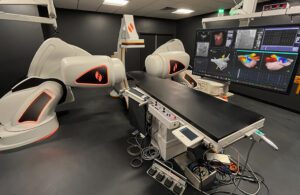
Count the Genesis RMN system, Vdrive robotic navigation system and Niobe robotic magnetic navigation system among Stereotaxis’ products. Stereotaxis provides surgical robotics that incorporates magnets for minimally invasive endovascular intervention.
The St. Louis-based company’s technology has treated more than 100,000 patients worldwide. In March, Stereotaxis opened a new 45,000-ft² headquarters facility in the renovated historic Globe Building in St. Louis’s Downtown North Urban Insight District.
Stereotaxis also added industry veterans to its executive team, with former Intuitive director Frank Van Hyfte and former Acutus Medical VP Tim Glynn joining this summer.
In a joint statement following their appointments, Van Hyfte and Glynn said Stereotaxis represents an opportunity to build “a preeminent robotic surgery company that positively transforms electrophysiology specifically and endovascular surgery more broadly.”
Monteris Medical: New data supports robot-guided laser therapy
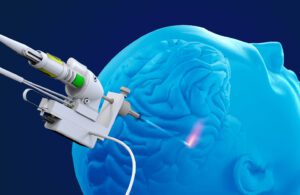
Minnetonka, Minnesota-based Monteris designed its NeuroBlate minimally invasive surgical robot system for controlled laser thermotherapy, known as laser interstitial thermal therapy (LITT).
NeuroBlate uses MRI-guided laser light to ablate (destroy) brain lesion(s) or unwanted tissue. Patients treated with NeuroBlate have had conditions including epilepsy, gliomas, brain metastases and radiation necrosis.
Earlier this year, the company published data on 89 patients from the Laantern prospective, multi-center registry. The data demonstrated that LITT offers an effective alternative to traditional surgery for patients with newly diagnosed and recurrent glioblastoma while also delivering the benefits of a minimally invasive surgical procedure, including short recovery time and the reduced potential for side effects.
The paper’s lead author, Division Chief of Neuro-Oncology at the University of California San Francisco Weill Institute for Neurosciences Dr. John de Groot called LITT “a critical tool for achieving maximal safe cytoreduction of the tumor.”
Zimmer Biomet: Happy with Rosa utilization uptick
Zimmer Biomet’s Rosa surgical robot has produced mixed results in terms of rentals compared to upfront sales, but the company maintains a positive outlook on the system.
EVP and CFO Suky Upadhyay said on the company’s second-quarter earnings call that installments remain strong and the company is “very happy with the continued uptick of Rosa and the utilization increases” it’s seeing.
COO Ivan Tornos added that Rosa represents a unique part of an “ecosystem” comprised of many parts and pieces. The integrated solution with pre-operation software through a partnership with Apple, for instance, creates a different offering in surgical robotics.
“If you go out there and ask physicians why — or payers, for that matter, why are they choosing Rosa; other than the outcomes and the technology at play, they like the efficiency, they like the fact that our preplanning is easier, they’re seeing the outcomes,” Tornos said. “And I think those are the reason why we’re seeing the great momentum with Rosa.”
Smith+Nephew: Cori still in early stages with ‘great potential’
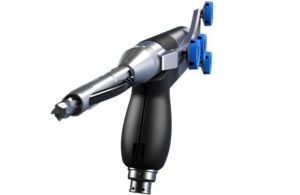
Smith+Nephew globally launched its Cori handheld surgical robot system last year and earlier this year added total hip arthroplasty to Cori’s offerings, having previously designed it for total knee arthroplasty.
On the company’s second-quarter earnings call, CFO Anne-Francoise Nesmes noted that Cori’s first assisted hip and cementless knee procedures were completed during the three-month period. In addition, Smith+Nephew expects “to become the first company to offer robot-assisted knee revisions” in the second half of this year, Nesmes said.
CEO Deepak Nath said the company sees “great potential” in Cori as a platform representing “a different paradigm.” He added that feedback from surgeons had provided a range of opinions, but the company is encouraged by early results.
“In Coriwe’ve got a platform that’s still in the early stages in terms of functionality and indications, but we’re adding to it… overnight,” Nath said. “That’s a change from the past where we now have a portfolio, and we’ve got enabling technologies to drive growth.”
The company first launched the Cori surgical system in 2020 in the U.S. after FDA clearance.
According to the company, Cori is a compact, fully mobile offering with a 3D intraoperative imaging system and an advanced robotic sculpting tool. The surgeon uses a pointer to digitally “paint” over the bone surface that needs removal. The surgeon then uses a handheld cutting tool that has a robotic feature. The robotic feature automatically halts the spinning of the tool’s burr if it’s outside the painted area.
EndoQuest: Scar-free surgery
Houston-based EndoQuest aims to provide endoluminal robotic surgery with zero scars and reduced trauma. (The company’s CEO Kurt Azarbarzin will speak during an upcoming DeviceTalks Weekly podcast.)
The company’s Endoluminal Surgical (ELS) system is still in the investigational stage with no FDA clearance at this time. It offers enhanced dexterity to rival that of an actual surgeon, according to the company. ELS is also meant to perform an array of procedures through several natural orifices.
Here’s how the surgical robotics landscape looked in early 2021>>
Associate editor Sean Whooley contributed to this report.